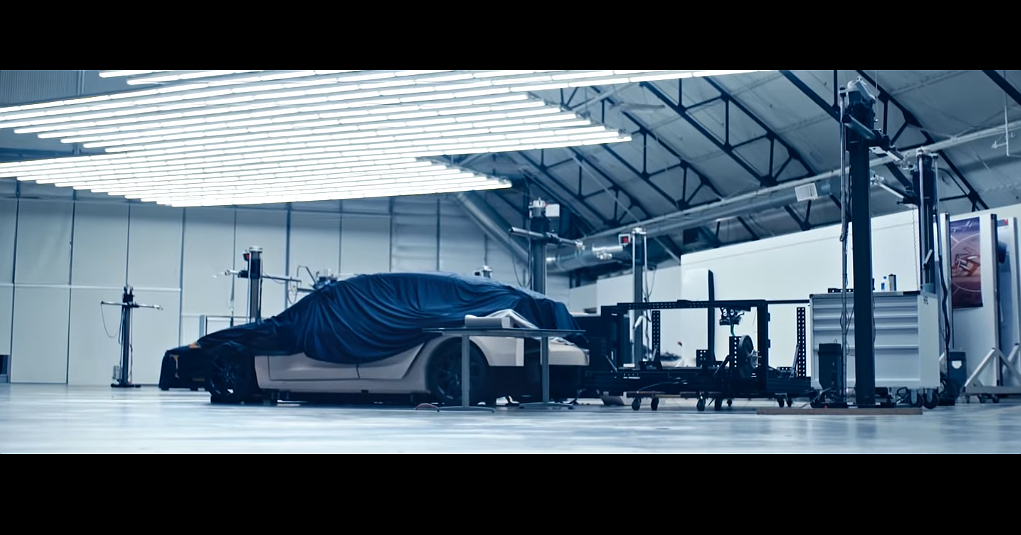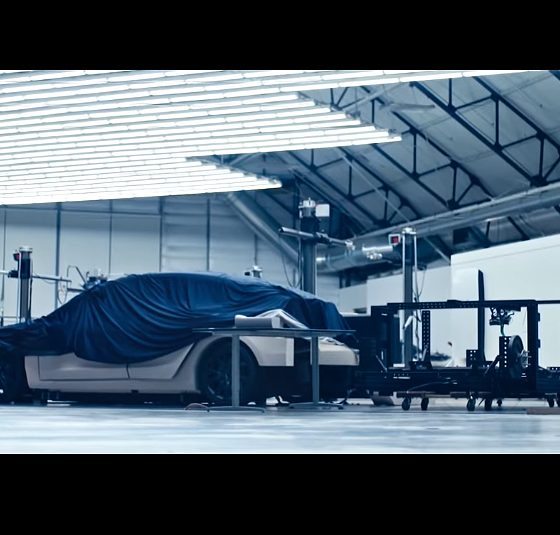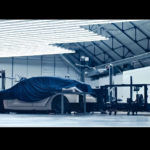A partially-covered vehicle featured in Tesla’s all-hands quarterly video has triggered speculations that the Elon Musk-led company just dropped a Model Y tease.
During the opening scenes of the recently-uploaded promo video, an image of a partially-covered, unidentified vehicle was featured. Based on what could be seen of the electric car, its design does not seem to match any of Tesla’s current offerings. With this, discussions in the Tesla community have pretty much erupted with speculations about what the vehicle could be.
Considering the angle of the mysterious vehicle, the car appears to be roughly the same length as a Model 3. The cloth covering of the electric car falls at a rather sharp angle in the rear as well, suggesting that the vehicle’s back might feature a rather angular, nearly vertical design. Interestingly, Tesla adopted a similar design in the past with the Model X SUV.
- The first image in Tesla’s all-hands quarterly video. [Credit: Tesla/YouTube]
- The mysterious, unidentified vehicle in Tesla’s promo video. [Credit: Tesla/YouTube]
The rear doors of the partially-covered vehicle do not match any of Tesla’s current offerings either. The rear Falcon Wing Doors of the Model X, for one, extend into the wheelbase, unlike the vehicle in Tesla’s promo video. The lines in the door profiles of the mysterious car’s body also curve upwards at the rear, unlike the Model S and Model 3. These factors, apart from a rather interesting post-it note in the clip’s opening moments, have fuelled speculations that the partially covered electric car was a Model Y prototype.
Not everyone is convinced that Tesla dropped a Model Y tease in the recently released video, however. In the r/TeslaMotors subreddit alone, several enthusiasts have noted that the partially covered electric car seems to have far too little ground clearance to be a crossover SUV. With this, some are speculating that the unidentified vehicle in the promo video features a redesigned Model S instead.
In a way, a Model S refresh makes sense for Tesla as well. The luxury all-electric sedan, after all, has been largely unchanged since it debuted back in 2012. A slight update in 2016 introduced a new front fascia and a couple of new interior options, but apart from these, the cars’ other design elements are still pretty much identical to the first vehicles that rolled off the production line. Considering the impending arrival of the Porsche Mission E — an electric car that appears to be tailor-fit to compete against the Model S — a full refresh of Tesla’s flagship sedan is just as likely.
These are, of course, just speculations and rumors for now, and hence, must be taken with a grain of salt. It should be noted, however, that Elon Musk loves the concept of Easter Eggs. Thus, the mysterious vehicle’s inclusion in the video definitely suggests that it is a pertinent project for Tesla in the near future.
During Tesla’s recently-held Q1 2018 earnings call, Elon Musk noted that an announcement about the Model Y’s factory would be released no later than the fourth quarter. Musk also stated that the next Gigafactory, which is set to be established in China, will incorporate facilities that would enable vehicle production. Musk also noted that the production of the Model Y would likely start around 2020.
The Model Y is a crossover SUV that is based on the Model 3 platform. According to Elon Musk, the Model Y would require only 100 meters of wiring — a significant reduction over the 1,500 meters required for the Model 3 and the 3,000 meters required for the Model S and X. Musk also expects the Model Y to be incredibly popular, with demand for the vehicle going as high as 1 million per year.
Watch Tesla’s all-hands quarterly promo video below.

News
Tesla starts showing how FSD will change lives in Europe
Local officials tested the system on narrow country roads and were impressed by FSD’s smooth, human-like driving, with some calling the service a game-changer for everyday life in areas that are far from urban centers.

Tesla has launched Europe’s first public shuttle service using Full Self-Driving (Supervised) in the rural Eifelkreis Bitburg-Prüm region of Germany, demonstrating how the technology can restore independence and mobility for people who struggle with limited transport options.
Local officials tested the system on narrow country roads and were impressed by FSD’s smooth, human-like driving, with some calling the service a game-changer for everyday life in areas that are far from urban centers.
Officials see real impact on rural residents
Arzfeld Mayor Johannes Kuhl and District Administrator Andreas Kruppert personally tested the Tesla shuttle service. This allowed them to see just how well FSD navigated winding lanes and rural roads confidently. Kruppert said, “Autonomous driving sounds like science fiction to many, but we simply see here that it works totally well in rural regions too.” Kuhl, for his part, also noted that FSD “feels like a very experienced driver.”
The pilot complements the area’s “Citizen Bus” program, which provides on-demand rides for elderly residents who can no longer drive themselves. Tesla Europe shared a video of a demonstration of the service, highlighting how FSD gives people their freedom back, even in places where public transport is not as prevalent.
What the Ministry for Economic Affairs and Transport says
Rhineland-Palatinate’s Minister Daniela Schmitt supported the project, praising the collaboration that made this “first of its kind in Europe” possible. As per the ministry, the rural rollout for the service shows FSD’s potential beyond major cities, and it delivers tangible benefits like grocery runs, doctor visits, and social connections for isolated residents.
“Reliable and flexible mobility is especially vital in rural areas. With the launch of a shuttle service using self-driving vehicles (FSD supervised) by Tesla in the Eifelkreis Bitburg-Prüm, an innovative pilot project is now getting underway that complements local community bus services. It is the first project of its kind in Europe.
“The result is a real gain for rural mobility: greater accessibility, more flexibility and tangible benefits for everyday life. A strong signal for innovation, cooperation and future-oriented mobility beyond urban centers,” the ministry wrote in a LinkedIn post.
News
Tesla China quietly posts Robotaxi-related job listing
Tesla China is currently seeking a Low Voltage Electrical Engineer to work on circuit board design for the company’s autonomous vehicles.

Tesla has posted a new job listing in Shanghai explicitly tied to its Robotaxi program, fueling speculation that the company is preparing to launch its dedicated autonomous ride-hailing service in China.
As noted in the listing, Tesla China is currently seeking a Low Voltage Electrical Engineer to work on circuit board design for the company’s autonomous vehicles.
Robotaxi-specific role
The listing, which was shared on social media platform X by industry watcher @tslaming, suggested that Tesla China is looking to fill the role urgently. The job listing itself specifically mentions that the person hired for the role will be working on the Low Voltage Hardware team, which would design the circuit boards that would serve as the nervous system of the Robotaxi.
Key tasks for the role, as indicated in the job listing, include collaboration with PCB layout, firmware, mechanical, program management, and validation teams, among other responsibilities. The role is based in Shanghai.
China Robotaxi launch
China represents a massive potential market for robotaxis, with its dense urban centers and supportive policies in select cities. Tesla has limited permission to roll out FSD in the country, though despite this, its vehicles have been hailed as among the best in the market when it comes to autonomous features. So far, at least, it appears that China supports Tesla’s FSD and Robotaxi rollout.
This was hinted at in November, when Tesla brought the Cybercab to the 8th China International Import Expo (CIIE) in Shanghai, marking the first time that the autonomous two-seater was brought to the Asia-Pacific region. The vehicle, despite not having a release date in China, received a significant amount of interest among the event’s attendees.
Elon Musk
Elon Musk and Tesla AI Director share insights after empty driver seat Robotaxi rides
The executives’ unoccupied tests hint at the rapid progress of Tesla’s unsupervised Robotaxi efforts.

Tesla CEO Elon Musk and AI Director Ashok Elluswamy celebrated Christmas Eve by sharing personal experiences with Robotaxi vehicles that had no safety monitor or occupant in the driver’s seat. Musk described the system’s “perfect driving” around Austin, while Elluswamy posted video from the back seat, calling it “an amazing experience.”
The executives’ unoccupied tests hint at the rapid progress of Tesla’s unsupervised Robotaxi efforts.
Elon and Ashok’s firsthand Robotaxi insights
Prior to Musk and the Tesla AI Director’s posts, sightings of unmanned Teslas navigating public roads were widely shared on social media. One such vehicle was spotted in Austin, Texas, which Elon Musk acknowleged by stating that “Testing is underway with no occupants in the car.”
Based on his Christmas Eve post, Musk seemed to have tested an unmanned Tesla himself. “A Tesla with no safety monitor in the car and me sitting in the passenger seat took me all around Austin on Sunday with perfect driving,” Musk wrote in his post.
Elluswamy responded with a 2-minute video showing himself in the rear of an unmanned Tesla. The video featured the vehicle’s empty front seats, as well as its smooth handling through real-world traffic. He captioned his video with the words, “It’s an amazing experience!”
Towards Unsupervised operations
During an xAI Hackathon earlier this month, Elon Musk mentioned that Tesla owed be removing Safety Monitors from its Robotaxis in Austin in just three weeks. “Unsupervised is pretty much solved at this point. So there will be Tesla Robotaxis operating in Austin with no one in them. Not even anyone in the passenger seat in about three weeks,” he said. Musk echoed similar estimates at the 2025 Annual Shareholder Meeting and the Q3 2025 earnings call.
Considering the insights that were posted Musk and Elluswamy, it does appear that Tesla is working hard towards operating its Robotaxis with no safety monitors. This is quite impressive considering that the service was launched just earlier this year.












